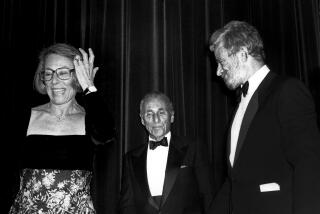Killing Themselves for a Reason : PASSIONATE WOMEN, PASSIVE MEN Suicide in Yiddish Literature <i> by Janet Hadda (State University of New York Press, Albany: $39.50, cloth; $12.95, paper; 223 pp.) </i>
As in life, literary characters sometimes have been emotionally or physically abandoned by a parent, suffering an inconsolable loss. As in life, they have sometimes committed suicide.
As in life, the suicide of a fictional character “is the culmination of a life gone awry,” Janet Hadda says in her post-Freudian psychoanalytic study of suicide in Yiddish literature. An associate professor of Yiddish at UCLA, Hadda has located a surprising number of examples from Yiddish stories in which a major character ends his or her life. From them she pieces together the thoughts, dreams and fantasies of these imaginary characters to create a life history explaining their suicides.
The study of literary characters using the psychoanalytic method is not novel. Hadda herself mentions famed psychoanalyst Heinz Kohut’s paper on Thomas Mann’s “Death in Venice.” What Hadda has done here is to investigate the barely recognized aspect of Yiddish literature dealing with suicide. Not only does her study conclude that suicide among Jews is not as rare as originally believed but also that these literary suicides appear to be united by certain common themes.
As if she were the analyst and the literary characters her patients, Hadda reconstructs from the literary narrative the backdrop that creates the despair that leads to suicide. She proves herself to be equally well-versed in current analytic theory and pre- and post-World War II Yiddish literature.
Hadda “treats” or psychoanalyzes her fictional patients. The men, she writes, “are chronically withdrawn or inert . . . The women, for their part, are too willful to be tolerated by conventional standards.” Most have failed to marry or, if married, do not remain so.
Just as clinicians have learned working with patients, Hadda finds that failures in early primary nurturing set the stage for a troubled adulthood of her fictional patients. As she states, “My goal throughout is to elucidate the early emotional deficits that Yiddish literary suicides have suffered, whether caused by physical or emotional insufficiencies. Again and again, these lacks proved to be major stumbling blocks (to the characters), preventing the socially necessary achievement of marriage and Jewish family life.”
The stories she has chosen from the first decades of the 1900s by such writers as Sholem-Aleykhem (sic) and Dovid Bergelson share the themes of failed relationships and unfulfilled longing for parental response. Consciously or unconsciously, these early writers have fashioned stories that reflect current psychoanalytic thought: suicide can stem from “the fundamental malaise that occurs when a child does not find an appropriate environment at the beginning of life.”
There are some questions about this work. Since the premise of this study is based on the taboo against suicide and its consequent infrequency among Jews, Hadda should have elaborated on the history of that prohibition.
Additionally, in attempting to validate her psychoanalytic thesis, Hadda often has to make far-reaching assumptions to find evidence in the stories of the early emotional or physical abandonment she argues are the cause of the later suicide. Her interpretations, while analytically sound, may lack grounding in the actual text.
Hadda is on much stronger ground in the last chapter where she discusses the post-Holocaust writings of Isaac Bashevis Singer. In that dislocated postwar era, suicide became understandable and acceptable within a culture that earlier had so strongly prohibited it. In a shattered world, the old morality had little meaning.
This is a refined book of particular interest to psychotherapists and those with an interest in Yiddishkeit . Hadda’s linkage of Yiddish literature and contemporary psychoanalysis follows the exploratory studies of Sigmund Freud and Theodore Reik to produce a provocative work.
More to Read
Sign up for our Book Club newsletter
Get the latest news, events and more from the Los Angeles Times Book Club, and help us get L.A. reading and talking.
You may occasionally receive promotional content from the Los Angeles Times.






